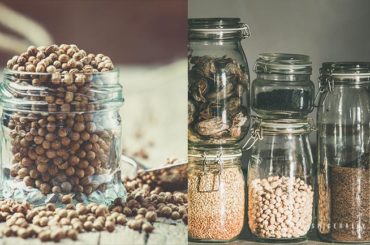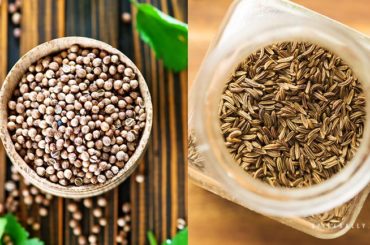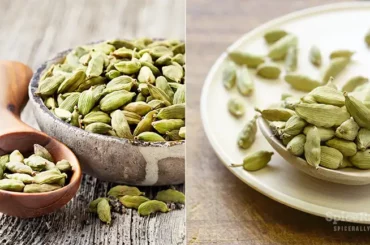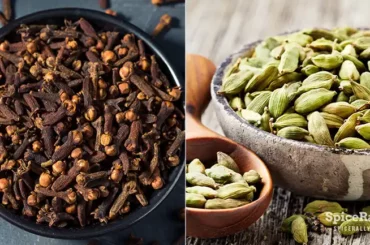The blend of spices of warm and spicy Indian food and their subtle flavors are genuinely fascinating. And they have that perfect ability to tantalize our senses.
South Indian spices are the predominant ingredient in most Indian dishes. Main spices like black pepper, turmeric, cardamoms, red chilis, fenugreek, and cinnamon are apparently essential flavor enhancers in many authentic South Indian recipes. Most of these spices have a well-renowned history for their medicinal properties and with traditional foods.
Thus, let us unfold a complete guide to South Indian spices before you. You will learn everything about the most unique and flavorful spices if you read till the end of this feature.
What Are South Indian Spices? – The Charm Of The South Indian Cuisine

South Indian cuisine has won its name a golden honor for providing the most unequaled and premium tasting foods over thousands of years to the world. In fact, it is among one of the best places where we get to taste spicy and flavorful dishes.
Above all, India is also perceived as the haven for spices. They have a range of authentic and traditional recipes in which they use most of their best flavorings. Although some of their spices like cinnamon, ginger, or turmeric are not strange flavors, seasonings like fenugreek, asafoetida, and mustard seeds can be very exotic to most of us.
South India is marked for its vegetarian dishes made using a lot of coconuts, rice, lentils, and of course, spices. There is a diversity of culinary art in different places in the Southern area. They open up to the world with various congenital recipes from Kerala, Andhra Pradesh, Karnataka, Udupi, and Tamil Nadu. However, all of these cuisines use spices as their master element for food.
“Indian food is like classical music raga; it takes time to build up to a crescendo“
Shobhaa De
So, let us see what South Indian spices we have enlisted for you. Read these interesting facts about the following relishes and learn what you could incorporate into your plate too.
Main South Indian Spices
The list below will explain in-depth about the main spices that are used in South Indian cuisine. Most of the recipes prepared by the hands of the South Indians hardly miss the below-mentioned flavorings.
01 – Black Pepper (Kali Mirch)
Black pepper is usually considered the king of spices in India. This spice is indigenous to the Malabar Coast of India. And, the Malabar pepper is widely grown there and in other tropical areas. Since the days of yore, dried, powdered, and roasted peppercorns have been employed both for flavoring and as legendary medicine in India.
Black pepper has a woody, summery fragrance that is carminative and intense. However, Indians add this into their dishes coarsely crushed.

South Indians use this hot spice in most of their seasoning blends too. Apart from being a must-have flavoring agent, black pepper has some excellent medicinal values too. It is known for its anti-cancer properties, anti-inflammatory effects, and potential to lower cholesterol and relieve the common cold and upset stomach
Here is a list of some popular relishes that South Indians make using black pepper:
- Tandoori Paneer Tikka
- Adai Dosa
- Kanchipuram Idli
- South Indian Rasam
- Spicy Pudina Chutney
Black pepper is a versatile spice used in many recipes including the Cajun Seasoning. If you are interested in knowing more about this seasoning, you are just one click away.
02 – Chili (Mirch)- The Most Popular South Indian Spice
If someone ever asks, “what is the most popular south Indian spice?”, they would probably answer you as “Mirch”! Actually speaking, South Indian food is nothing without the incredibly hot and spiciness of chili.
In fact, it is the most regularly employed spice in the kitchens of South India. The most spiciness of chili comes from their seeds. So, if anyone needs them less spicy, they can remove the seeds and use only the flesh.

5 Types of chillies that are mainly used in southern Indian cuisine
- Kashmiri Red Chili – a deeply red-colored variety of chili originating from Kashmir. This is not very spicy and often used in its powdered form.
- Salem Gundu (Indian Dry Red Chili) – Salem Gundu got its name for its appearance as they are small and round. This variety is also another popular add-on in South Indian savories coming from Tamil Nadu with medium hotness.
- Guntur – One of the most popular varieties of red chili from Andhra Pradesh which is very hot and spicy.
- Byadagi – This type of chili is long and wrinkled in its appearance. Deep red in color and has an intense aroma but is not very hot. This red chili originated from Karnataka.
- Dhani (bird’s eye chili) – This is an intensely hot and prickly-tasted type of chili coming from Manipur.
As you see, South Indian cuisine has an everlasting bond with chili. In fact, they are often obsessed with the color, aroma, and spiciness they add to the food. In South India, Guntur is the common and most used variety of red chili. This type gives out a similar flavor to Arbol Chili or cayenne peppers. At the same time, Byagadi gives a similar taste to paprika.
In addition to these red chilies, Indians also use green chili, which has a slightly different taste, aroma, and green in color. Green chilies are usually used raw in food or included in curry pastes and chutneys they make. However, they use red chili as dried, whole, crushed, or powdered. Just see if you come across any of these popular South Indian recipes made using chili:
- Red Chili Coconut Chutney
- South Indian Chili Chicken
- Authentic South Indian Biryani
- Chettinad Egg Curry
- Dry Red Chili and Tomato Chutney
03 – Turmeric (Haldi/ Manjal)
Turmeric is a fundamental ingredient in South Indian cuisine. In North India, turmeric is known as “Haldi,” and in the South, it is popularly known as “Manjal ”. Mainly there are two types of turmeric used in India.
The ordinary turmeric we all know is basically used as a flavor and a color enhancer in cooking. While, the other type, “Kasturi Manjal ”, designated by the scientific term Curcuma aromatica, is widely employed as an Ayurvedic, herbal, or beauty constituent in South India.

Moreover, in southern India, the dried turmeric rhizome is usually worn in an ornament as camouflage against evil. And they believe it has the ability to bring them good fortune and contains healing properties. It has a pleasant earthy fragrance, and raw turmeric has a trace of bitter and spicy taste.
South Indians often use it in its powdered form or as a paste to include in foods. Most of the time, they add it in with vegetables and lentils to give those dishes a bright golden tint and taste. Plus, they also make turmeric-infused milk which they call “Golden Milk”. However, Kasturi Manjal is not included in food as it is too bitter in flavor than ordinary turmeric.
Furthermore, turmeric has some valuable medicinal values. It has anti-fungal and anti-inflammatory properties and also provides possible protection against heart diseases and eases arthritis pains. Here are a few South Indian recipes prepared using turmeric:
- Fresh Turmeric Thokku
- Manjal Dosai
- South Indian Turmeric Curd Rice
- Turmeric-infused Vegetable Curry
- South Indian Style Aloo Rasedar
04 – Cinnamon (Pattai)
This spice is a leading ingredient in most vegetarian/vegan and non-veg dishes made in South Indian cuisines. Indians use cinnamon in most of their curries and also include it in elemental and staple curry powders.
The most famous meat spice mixture, Garam Masala, also contains cinnamon as one of the main ingredients. Ceylon Cinnamon is prominently used by the South Indians, which is an influential factor for their food and spice mixtures to be high in taste and quality.

If cinnamon is not included as a sub-ingredient of a spice mixture, it is often incorporated with hot oil in most South Indian recipes. Moreover, they use this spice as quills, broken into small pieces, and used as a powder, too. This gives their dishes an irresistible aroma and flavor when mixed with other ingredients.
Cinnamon has a sweet, fresh, and woody flavor and its taste becomes doubled when powdered. Apart from using this spice as a flavoring or seasoning agent, it also has some expected health benefits. It provides potential help in lowering blood sugar levels and promoting weight loss. Check out these famous South Indian food items, which include cinnamon in them:
- Classic Mutton Biryani
- South Indian Chicken Curry
- Mysore Saaru Podi
- Korma
- Classic South Indian Chicken Fry
Cinnamon is a spice worth knowing! So, if you are interested in discovering more about this flavoring, we have a detailed guide to types of cinnamon here.
05 – Cardamoms (Elaichi)
Bodinayakanur, in Tamil Nadu of South India, is the home for cardamoms, and they are considered the best in the world. This area is known as the Cardamom City, which contributes to the land from millions of dollars each year.
This little pod of spice is very intense in aroma and tastes great when added to various dishes. In fact, cardamom has the ability to twist-turn the smell and taste of an entire dish.

South Indians mostly use cardamoms in their spice mixtures like Garam Masala and also in savories. They use them as a whole or extract the seeds from the green peel and make it into powder.
The powder itself is usually very pungent in aroma and zest once removed from the peel. Apart from the unique taste and fragrance, cardamoms have a few medicinal attributes too.
They are abundant in Vitamin C, Vitamin A, Thiamine, and Calcium. And, possess properties in relieving urinary tract diseases and improving blood circulation. Just check if you have come across any of these South Indian dishes that contain cardamom:
- Chai Masala (Indian Masala Tea Powder)
- Mohanthal
- South Indian Coconut Rice Pudding (Kheer)
- Rice Payasam
- Chickpea Curry
06 – Fenugreek (Methi Seeds)
Fenugreek is a tiny and hard seed that is very bitter and tangy in taste. South Indians often use this spice in most of their savory or spicy recipes. And, they grind or dry roast them in order to obtain more fragrance and flavor from them. Fenugreek seeds blend well when sauteed with curry leaves, coconut oil, and pandan leaves.

Generally, it can be incredibly bitter when consumed fresh. But, when mixed and cooked with other fragrant spices like coriander and cumin, it converts and provides saucy dishes with sweetness and a deep, unique flavor.
According to the data we collected, we acknowledged that the classic Garam Masala recipe of the South Indians has fenugreek in it to balance the spices used in that mixture. And they also include fenugreek leaves in certain recipes.
However, besides the excellent flavor intensification it gives to the food, fenugreek has some essential medicinal properties like all other spices on our list. It is well-known for reducing blood sugar levels and regulating cholesterol levels. Here is a list of famous South Recipes that has fenugreek in them:
- Aloo Methi
- Methi Dal
- Vendhaya Kuzhambu (Fenugreek Seeds Gravy)
- Fenugreek Rasam
- Methi Chole
07 – Cloves (Laung)
Used basically in Karnataka, Tamil Nadu, and Kerala, cloves are a staple tempering spice in South India. In addition, they use this small dark brown spice in most of their spice blends. They are often available as whole pods but can also be added into food when dry roasted and ground into a powder. Cloves have a rich, sweet aroma and tropical, pungent taste.

Moreover, mainly in the Maharashtra region of South India, it is employed for sweet or savory dishes. If you have a toothache, cloves and clove oil can be the ideal life-saver. They are excellent for oral-related health issues, especially to maintain a fresh breath. In addition, cloves also have the ability to kill bacteria and may also help in reducing stomach ulcers. Let us bring you some South Indian dishes made using cloves:
- Ghee Mutton Roast
- South Indian Sambar
- Eggplant Curry
- South Indian Chicken Biryani
- South Indian Malabari Curry
08 – Mustard Seeds (Sarso/ Rai)
Mustard is a never-failing ingredient in South Indian cuisine. They are obtained from different plants. These seeds are little round, firm seeds that can be brown, black, or white in color.
The black seeds are incredibly aromatic, and as they are tough to harvest, they can be pretty high in cost. Even though the white seeds are more delicate, they can still have a flavor comparable to the black seeds.

However, black and brown mustard seeds are the ones that come to South Indian cuisine most of the time. When cooking with them, most often, they are sauteed with hot oil at the start of the dish. And then cook until they pop and discharge their unique peppery tang and add an eccentric taste to the recipe.
South Indians use mustard in distinct spice blends, and mustard oil is also used for various purposes. This tiny seed has some significant medicinal values like the benefits on bones and is known for its high anti-inflammatory effects. Check out these recipes prepared with mustard in South India:
- South Indian Cabbage Black Mustard Seeds
- Mustard Greens Curry
- South Indian Potato Masala
- Dakshin Murgh (South Indian Style Chicken Curry)
- Masoor Dal (South Indian Red Lentils)
09 – Asafoetida (Hing)
Asafoetida is a very unique spice used in South Indian cuisine for its garlic and onion-like distinct flavor. It endorses the most commonly-employed Indian vegetables like their quick-cooked greens, cauliflower, potatoes, onions, peas.
However, preparing a more complex vegetable curry or a more simplistic sauté, a pinch or two added at the source could add a great flavor to the food. South Indians add asafoetida and let it combine for about 15 seconds before adding other spices and seasonings.

South Indians primarily include this spice in their recipes in its powdered form. In fact, asafoetida is excellent when used as a background key for other courtesy flavorings, like mustard, curry leaves, cumin, dried chili, garlic, and ginger.
Apart from its unique flavor and aroma, asafoetida possesses some remarkable health benefits. It has antibacterial properties and has potential health in protecting the brain. Here is a list of South Indian asafoetida dishes:
- Kerala Style Sambar
- South Indian Curry Leaf Rice
- Andhra Style Ingavu Chaaru
- South Indian Tamarind Rice
- South Indian Fish Curry
Thai spices are not less notable than South Indian spices. So, if you are intrigued by learning about those Thai spices, we have an article here.
Differences Between Northern & Southern Indian Spices
The main discrepancy between northern and southern Indian spices is the change of spiciness they have. In fact, southern cuisine makes more hot and spicy dishes than Northern cuisine. However, despite a few differences, the basic set of spices like cardamoms, black pepper, and coriander are the same in both regions.
Although the North and South Indian practice of spices are somewhat similar, the proportions of particular spices that provide that exceptional flavor point tend to be complex. If you need an example, North Indian cuisine utilizes cumin. But South Indian recipes replace it with mustard. And South Indians use curry leaves while North Indians substitute them with fenugreek leaves.
The Ultimate Touch Of Spiciness…
Whatever the flavors and different spices they use, South Indian cooking wins a striking place in people’s hearts all over the world. As you see, the spiciness and savoriness of their dishes essentially come from the proficiency of blending the spices of the South Indians. Spices are indeed an integral part of their art of cooking, and they have the capacity to give the perfect touch of heavenly taste to satisfy everyone’s taste buds.




